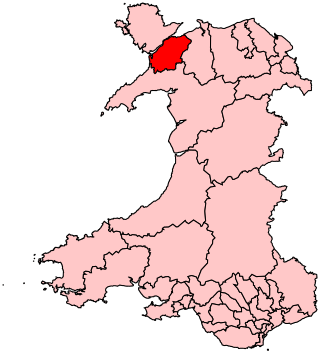Top Qs
Timeline
Chat
Perspective
Arfon (UK Parliament constituency)
UK Parliamentary constituency, 2010–2024 From Wikipedia, the free encyclopedia
Remove ads
Arfon was a constituency in Wales represented in the House of Commons of the UK Parliament at Westminster.[n 1] Although it is relatively large by geographical area, the constituency is a predominantly urban rather than rural seat, with the majority of the population living in the two towns of Bethesda and Caernarfon, as well as in the city of Bangor, on which the constituency is based. "Arfon" is a historical name for the area, meaning "facing Anglesey"; it is also the name of the former district council. This seat was created by the Welsh Boundary Commission in time for the 2010 general election; it replaced the old seat of Caernarfon. Bangor was in the old seat of Conwy. The same boundaries were used for the Arfon Welsh Assembly constituency in the 2007 Welsh Assembly election.
Prior to its abolition, it was the smallest constituency on the mainland of Great Britain by electorate, and larger only than the two Scottish island constituencies, Na h-Eileanan an Iar and Orkney and Shetland. The total population as of the 2011 census was 60,573.
The Arfon division of Caernarvonshire was a former UK Parliament constituency, which existed from 1885 until 1918. Before 1885 and after 1918 the area was part of the Caernarvonshire constituency. The Liberal MP William Rathbone represented the Arfon seat until 1895, followed by fellow Liberal William Jones. Upon the death of Mr Jones, Griffith C. Rees, for the Liberal Party, was elected unopposed at the subsequent by-election.[3]
On 11 November 2022, the then current MP Hywel Williams announced his intention to stand down at the 2024 general election after more than 20 years as MP.[4]
The constituency was abolished as part of the 2023 Periodic Review of Westminster constituencies and under the June 2023 final recommendations of the Boundary Commission for Wales. Its wards were split between Bangor Aberconwy and Dwyfor Meirionnydd.[5]
Remove ads
Boundaries
When first created in 1885, the constituency was defined as the Petty Sessional Divisions of Bangor, Conway and Nant-Conway, with the Parishes of Llanddeiniolen and Llanberis (which were within the Carnarvon Petty Sessional Division). The constituency included the boroughs of Bangor and Conway which were part of the Carnarvon District of Boroughs constituency; only those who owned freehold land within the boroughs could vote in elections for the Arfon constituency as a second vote.
The new constituency was a merger of northern Caernarfon and western Conwy. The electoral wards used to create the current constituency are entirely within the preserved county of Gwynedd; They are Arllechwedd, Bethel, Bontnewydd, Cadnant, Cwm-y-Glo, Deiniol, Deiniolen, Dewi, Garth, Gerlan, Glyder, Groeslon, Hendre, Hirael, Llanberis, Llanllyfni, Llanrug, Llanwnda, Marchog, Menai (Bangor), Menai (Caernarfon), Ogwen, Peblig, Penisarwaun, Pentir, Penygroes, Seiont, Talysarn, Tregarth and Mynydd Llandygai, Waunfawr and Y Felinheli.
Remove ads
Demographics
Welsh language
Welsh is the main language spoken in Arfon, and it has the highest percentage of people who can speak a Celtic language of any constituency in the world. As of June 2024, 84.8% of residents over the age of three could understand spoken Welsh, including 96.8% of those who were born in Wales.[6]
Electoral history
The latest boundary change created a battleground in Arfon particularly for Labour, Plaid Cymru, and the Conservatives, with the latter being labelled as a 'resurgent' party by the Caernarfon Herald.[7] The scale of contention had been reached due to the large shift in boundary changes which in turn created a need within each party to achieve a relatively unforeseen outcome. Plaid Cymru had previously never represented Bangor, which had been held by Conservative Wyn Roberts for twenty-seven years and a further thirteen under Labour's Betty Williams. It had however also been more than thirty years since Caernarfon had been represented by anyone other than Plaid Cymru.
In the event, Plaid gained the seat (which had been notionally Labour) in 2010 and held it in 2015; their victory in 2017 was by just 92 votes, the tightest margin in Wales in that election.
Members of Parliament
MPs 1885–1918
MPs since 2010
Remove ads
Elections
Summarize
Perspective

Elections 1885–1918
Elections in the 1880s
Elections in the 1890s
Elections in the 1900s

Elections in the 1910s
Elections in the 21st century
Elections in the 2010s
*Served as MP for the predecessor seat of Caernarfon in the 2001-2010 Parliament
Remove ads
See also
Notes
- As with all constituencies, the constituency elects one Member of Parliament (MP) by the first past the post system of election at least every five years.
References
External links
Further reading
External links
Wikiwand - on
Seamless Wikipedia browsing. On steroids.
Remove ads


